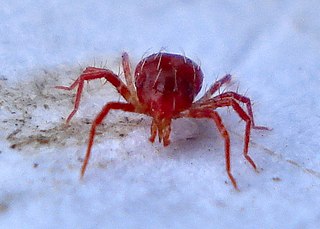Related Research Articles

The Phytoseiidae are a family of mites which feed on thrips and other mite species. They are often used as a biological control agent for managing mite pests. Because of their usefulness as biological control agents, interest in phytoseiids has steadily increased over the past century. In 1950, there were 34 known species. Today, there are 2,731 documented species.

Mesostigmata is an order of mites belonging to the Parasitiformes. Unlike most members of that group, many of these mites are not parasitic but free-living and predatory. They can be recognized by the single pair of spiracles positioned laterally on the body.
The Amblyseiinae are a subfamily of mites in the Phytoseiidae family.
Typhlodrominae is a subfamily of mites in the Phytoseiidae family.
Amblyseiella is a genus of mites in the Phytoseiidae family.
Amblyseiulella is a genus of mites in the Phytoseiidae family.
Chelaseius is a genus of mites in the Phytoseiidae family.
Eharius is a genus of mites in the Phytoseiidae family.
Fundiseius is a genus of mites in the Phytoseiidae family.
Indoseiulus is a genus of mites in the Phytoseiidae family.
Macroseius is a genus of mites in the Phytoseiidae family.
Okiseius is a genus of mites in the Phytoseiidae family.
Paragigagnathus is a genus of mites in the Phytoseiidae family.
Paraphytoseius is a genus of mites in the Phytoseiidae family.
Phyllodromus is a genus of mites in the Phytoseiidae family.
Phytoscutus is a genus of mites in the family Phytoseiidae.

Phytoseiulus is a genus of mites in the Phytoseiidae family. A predatory mite, this is the mite predator most frequently used to control two-spotted spider mites in greenhouses and outdoor crops grown in mild environments. This mite was accidentally introduced into Germany from Chile in 1958; it was subsequently shipped to other parts of the world, including California and Florida, from Germany. A Phytoseiulus mite can consume up to seven adult spider mites or several dozen of their eggs in a day. Adult females are reddish, pear-shaped, about 0.5 mm long, and active at room temperature. Immatures and males are smaller and lighter in color. Eggs are oblong. About 80% are females. At optimum temperatures, Phytoseiidae can develop from egg to adult in 7 days and live up to a month. A well-fed female lays about 50 eggs in her lifetime.
Amblyseius ankaratrae is a species of mite in the Phytoseiidae family. It was described by Blomners in 1976.
Amblyseius aricae is a species of mite in the Phytoseiidae family. It was described by Karg in 1976.
Amblyseius bellatulus Tseng is a species of mite in the Phytoseiidae family that is native to Taiwan. It was described by Tseng Yi-Hsiung in 1983. Following his retirement, Tseng's collection of more than 20 holotypes of Taiwanese phytoseiid fauna were lost. A. Bellatulus re-described in 2017 by a team from National Taiwan University led by Liao Jhih-Rong, who collected new specimens of phytoseiid mites from the original locale used by Tseng as well as other areas throughout Taiwan.
References
- ↑ Dr. Gilberto Jose de Moraes (2005). Phytoseiidae Species Listing. Biology Catalog, Texas A&M University. Retrieved on August 19, 2010.
| This article about a mite or tick is a stub. You can help Wikipedia by expanding it. |